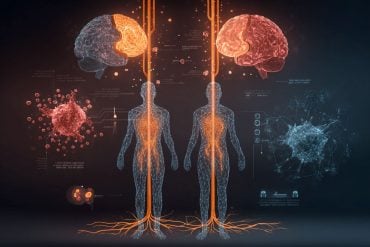Summary: Researchers say those who use both cannabis and nicotine have greater brain connectivity that those who take one or the other. The networks of those who used both substances closely resembled those who people who took neither drug.
Source: Center For BrainHealth UT Dallas.
Researchers at the Center for BrainHealth at the University of Texas at Dallas investigated the effects on the brain of concurrent cannabis and nicotine use, versus the use of solely cannabis and solely nicotine.
The results, recently published in the journal Brain Structure and Function, show that not only were the effects in these three categories different, but also that the group using both nicotine and cannabis more closely resembled the control (non-user) group in brain connectivity. The isolated nicotine and isolated cannabis users showed equally less connectivity in general.
Previous research in rats has suggested that nicotine may be a “gateway drug” leading to cannabis and other drug use. Studies performed with rats exposed to THC – the main psychoactive compound found in marijuana – demonstrated an increased likelihood to self-administer nicotine that was not observed with rats exposed to heroin or cocaine, suggesting that there is something unique about the cannabis-nicotine interaction.
“Most of the literature to date has focused on associations of isolated cannabis and nicotine use, even though concurrent cannabis and nicotine use is more prevalent in society than cannabis use alone,” said the study’s lead author, Dr. Francesca M. Filbey, the Bert Moore Chair in BrainHealth at UT Dallas. “Our findings confirm the limitations of existing research.”

While the outcome of the study could be, in part, due to the opposing effects nicotine and cannabis have on the brain, the difference in the brains of concurrent users versus isolated users of each product begs for further research in functional connectivity metrics in these populations, Filbey said.
MRI scans were used to evaluate resting state functions in 12 different regions of the brain among four groups of participants: 28 nicotine users, 53 cannabis users, 26 nicotine and cannabis users, and 30 non-users in a control group. These scans revealed that the control group displayed greater connectivity in almost all of the networks compared to the nicotine and cannabis groups, while the combined nicotine plus cannabis group had greater connectivity than the only-nicotine and only-cannabis groups. Notably, this study did not demonstrate a correlation between substance use severity and functional connectivity.
Differences in brain network connectivity suggest alterations in the underlying neural architecture of the brain that support brain function. Overall, Filbey said the study suggests unique and combined contributions of cannabis and nicotine on brain network connectivity, which could be helpful knowledge for intervention programs.
Funding: This study was funded by the National Institutes of Health (numbers K01 DA021632, R01DA030344-01A1 and R01 DA038895).
Source: Stephanie Hoefken – Center For BrainHealth UT Dallas
Publisher: Organized by NeuroscienceNews.com.
Image Source: NeuroscienceNews.com image is in the public domain.
Original Research: Abstract for “Differential associations of combined vs. isolated cannabis and nicotine on brain resting state networks” by Francesca M. Filbey, Suril Gohel, Shikha Prashad, and Bharat B. Biswal in Brain Structure and Function. Published June 7 2018.
doi:10.1007/s00429-018-1690-5
[cbtabs][cbtab title=”MLA”]Center For BrainHealth UT Dallas”Differences Between Combined and Isolated Cannabis and Nicotine Use on Brain Networks.” NeuroscienceNews. NeuroscienceNews, 28 August 2018.
<https://neurosciencenews.com/cannabis-nicotine-9763/>.[/cbtab][cbtab title=”APA”]Center For BrainHealth UT Dallas(2018, August 28). Differences Between Combined and Isolated Cannabis and Nicotine Use on Brain Networks. NeuroscienceNews. Retrieved August 28, 2018 from https://neurosciencenews.com/cannabis-nicotine-9763/[/cbtab][cbtab title=”Chicago”]Center For BrainHealth UT Dallas”Differences Between Combined and Isolated Cannabis and Nicotine Use on Brain Networks.” https://neurosciencenews.com/cannabis-nicotine-9763/ (accessed August 28, 2018).[/cbtab][/cbtabs]
Abstract
Differential associations of combined vs. isolated cannabis and nicotine on brain resting state networks
Concomitant cannabis and nicotine use is more prevalent than cannabis use alone; however, to date, most of the literature has focused on associations of isolated cannabis and nicotine use limiting the generalizability of existing research. To determine differential associations of concomitant use of cannabis and nicotine, isolated cannabis use and isolated nicotine use on brain network connectivity, we examined systems-level neural functioning via independent components analysis (ICA) on resting state networks (RSNs) in cannabis users (CAN, n = 53), nicotine users (NIC, n = 28), concomitant nicotine and cannabis users (NIC + CAN, n = 26), and non-users (CTRL, n = 30). Our results indicated that the CTRL group and NIC + CAN users had the greatest functional connectivity relative to CAN users and NIC users in 12 RSNs: anterior default mode network (DMN), posterior DMN, left frontal parietal network, lingual gyrus, salience network, right frontal parietal network, higher visual network, insular cortex, cuneus/precuneus, posterior cingulate gyrus/middle temporal gyrus, dorsal attention network, and basal ganglia network. Post hoc tests showed no significant differences between (1) CTRL and NIC + CAN and (2) NIC and CAN users. These findings of differential associations of isolated vs. combined nicotine and cannabis use demonstrate an interaction between cannabis and nicotine use on RSNs. These unique and combined mechanisms through which cannabis and nicotine influence cortical network functional connectivity are important to consider when evaluating the neurobiological pathways associated with cannabis and nicotine use.






